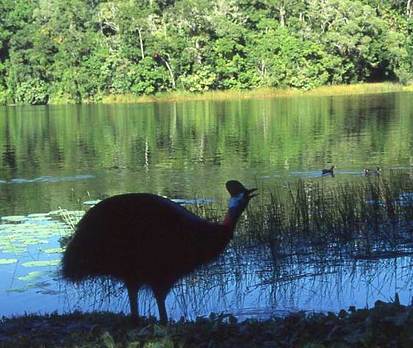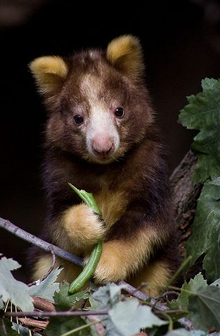|
Another creature that plays an important role in my upcoming novel, SAVAGE (as well as the title role in my short story, BLUE ARROW) is the Cassowary. The Eastern Turkey is possibly the most impressive bird you’ll see in Missouri. When you see one, you think, “Cool, a turkey.” But when you lay eyes on a cassowary, you think, “Holy !$*#!, it’s a dinosaur!” The cassowary is the second heaviest bird (the Ostrich is first), and they live in New Guinea, its surrounding islands, and northern Australia. Trish and I were lucky enough to see a cassowary while on a rainforest hike in Queensland, Australia. We took video of it, but we could never show that video to our students because Trish, who was holding the camera, kept exclaiming, “Oh, Sh**! Oh, sh**! It’s a cassowary!” Yeah, it’s that exciting to see one.
These birds, which are about five feet tall and weigh up to 130 pounds, have a reputation for being aggressive (although, as usual, people’s opinions about this are exaggerated). When we would hike in areas where they lived, warning signs were posted at trailheads, and brochures about them were readily available. When Australians describe the dangers of cassowaries, they are fond of using the word “disembowel.” An unpleasant word, by any measure, but a cassowary has very sharp claws on its three dinosaur-like toes that are capable of doing some damage. Cassowaries, have a large, bony helmet, or casque, growing from the top of the head, but no one is quite sure of its function. Researchers have suggested it is used as a battering ram to protect the head as the bird runs through the thick tropical forest at up to 31 mph. Regardless, cassowaries are the most bone-headed birds I know of. Cassowaries can also jump 7 feet straight up, and they can swim wide rivers! Impressive, huh? So the Cassowary is another animal deserving of the BAHF, and this time it stands for the “Bosker Animal Hall of Fame.” Fun Fact: Bosker is another Australian and New Zealand slang adjective, which also means “Awesome.”
0 Comments
Since a tree kangaroo has an important role in my upcoming novel, Savage, as well as in my novels, Diffusion and Infusion, I thought I would expound upon this creature’s awesomeness. Yes, tree kangaroos are real! They live on the island of New Guinea, but also in very northern Australia and some of the Indonesian islands. Why are tree kangaroos so cool? Well, because they’re kangaroos—that live in trees! When Australian Aborigines and Papuan (New Guinea) natives told early European explorers about tree kangaroos, the explorers refused to believe the stories. You have to admit it seems pretty unlikely, right? These creatures eat, sleep, and breed in the treetops, but that doesn’t mean they live a comfortable existence. First of all, I imagine breeding in the treetops requires some caution (yikes!). Second, they seem to be a tasty meal for their primary predator, the amethystine python (which have a habit of hugging much too tightly). Third, natives hunt them for food (In New Guinea, "the man who has successfully hunted a tree-kangaroo has greatness bestowed upon him. He has conquered the largest, most prestigious and human-like marsupial known to his people." [Tim Flannery, from the awesome book, Throwim Way Leg]). And fourth, they depend on pristine rainforest, and if you haven’t heard, rainforests are getting smaller every day (a real bummer).
Some tree kangaroos are extremely rare and live in places so remote that they are unusually tame, as they have never learned to fear humans. The Papuan people of New Guinea have numerous ancient myths about tree kangaroos, some of which play a role in my novels. There are about 14 different species, but this is one of very few types of large mammals with species still being discovered. Most tree kangaroos are about the size of a housecat. They are a fascinating example of divergent evolution (when groups of similar creatures become isolated and gradually diverge in form and function). Long ago, groups of ground-dwelling kangaroos became isolated in areas of dense tropical forest, as opposed to the open grasslands more typical for kangaroos. Once isolated in rainforest areas, they developed the ability to climb trees. So, in summary, Tree Kangaroos are worthy of the BAHF, the “Budgeree Animal Hall of Fame.” Budgeree is an Australian colloquialism that dates back to the 18th century, and derives from an Aboriginal language – it is loosely translated as “Awesome.” |
Stan's Cogitations
Everyone needs a creative outlet. That's why I write. Archives
April 2024
|




 RSS Feed
RSS Feed